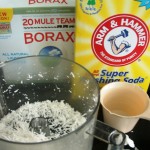 I have been reading Trent’s tips over at The Simple Dollar for a couple of years now, and I have to say that his idea of frugal and mine match up pretty nicely. In general, it’s all about choosing what you want to spend money on and deciding what you want to spend your time on. That being said, I must note that while I was fully (perhaps even over) employed, I never would have taken the time to make laundry detergent. It wouldn’t have been worthwhile for me to spend the time hunting ingredients down in the grocery store and grating soap and mixing up a huge bucket of slime. Not even at 15¢ a load in savings (which is about what Trent calculated). With the five loads of laundry I do each week, that would put us at 75¢ in savings each week, or just under $40 a year. Still wouldn’t have been worth it back then.
I have been reading Trent’s tips over at The Simple Dollar for a couple of years now, and I have to say that his idea of frugal and mine match up pretty nicely. In general, it’s all about choosing what you want to spend money on and deciding what you want to spend your time on. That being said, I must note that while I was fully (perhaps even over) employed, I never would have taken the time to make laundry detergent. It wouldn’t have been worthwhile for me to spend the time hunting ingredients down in the grocery store and grating soap and mixing up a huge bucket of slime. Not even at 15¢ a load in savings (which is about what Trent calculated). With the five loads of laundry I do each week, that would put us at 75¢ in savings each week, or just under $40 a year. Still wouldn’t have been worth it back then.
Now that I have long days to fill and since I’m working on this whole housewife thing, $40 a year is looking a lot better. That’s nearly two free cases of beer at the local Costco, people! And I’m talking the good, local, micro-brew stuff, not silver cans. We must have priorities on what we spend those dollars on! Besides, I was almost out of the detergent that I’d purchased months ago, so I figured it was time to give the homebrew method a try. I followed Trent’s recipe pretty exactly, and I ended up this morning with a large bucket of slime, just like he promised. I did my first load of laundry with it this morning, so I can tell you my thoughts.
I was concerned at first because the water didn’t get all bubbly when I poured the cup of detergent in. I thought I might not have added enough, so I put a little more in and still no bubbles. It did smell soapy though, and I decided to go for it. For this experimental load, I had kitchen towels that were smeared with pesto remnants and tomato paste and such. They would normally come out of my regular laundry detergent load without many stains (I don’t bother to pre-treat stains on my kitchen towels – if you take issue with stains on my dish towels, you probably shouldn’t come to my house). I thought this would be a good test, and when I pulled the towels out of the washer, their stains were at least as gone as they normally would be. However, they still kind of smelled like whatever they’d had on them before. Not a ton, but I don’t want my laundry to have even the faintest whiff of its previous smell once it’s clean. Don’t worry – all was not lost!
Before I started the laundry this morning, I gave the bucket a bit of a stir. Trent says that there will be more solid globs floating in your detergent and not to worry about it, and that’s basically what mine looked like. However, I hadn’t given the detergent a real stir, since I forgot to bring anything down to the laundry room that would be long enough to stir the bottom of the bucket. I decided that I should try stirring it up a bit more, and found a layer of gelatinous goo on the bottom of the bucket. So I stirred enough that the layer got dispersed throughout the bucket and threw another scoop into the machine. The laundry came out with a complete lack of smell, and the stains were at least as clean as they would normally be. This recipe seems to be a total success!